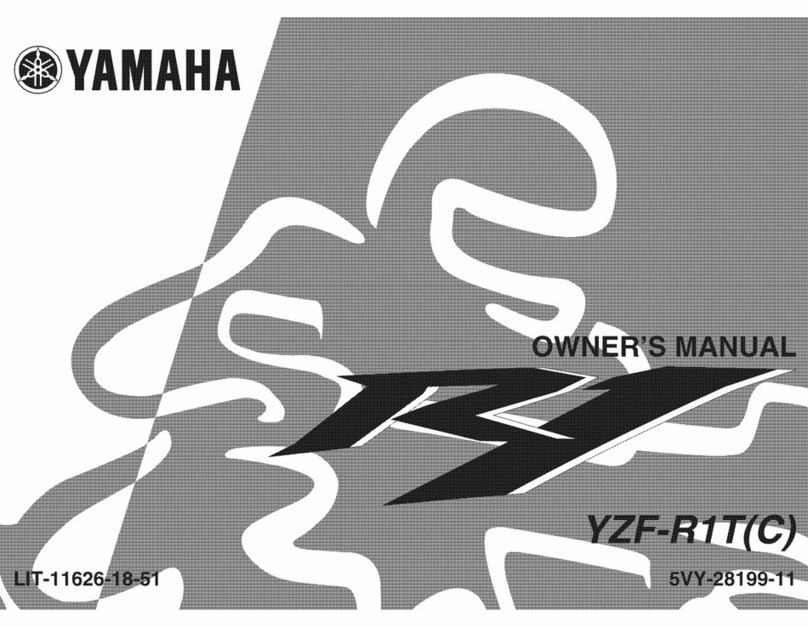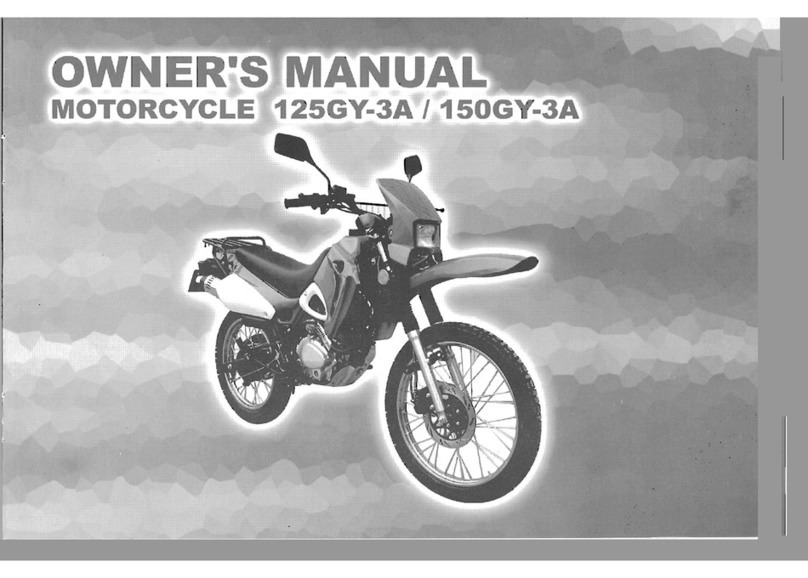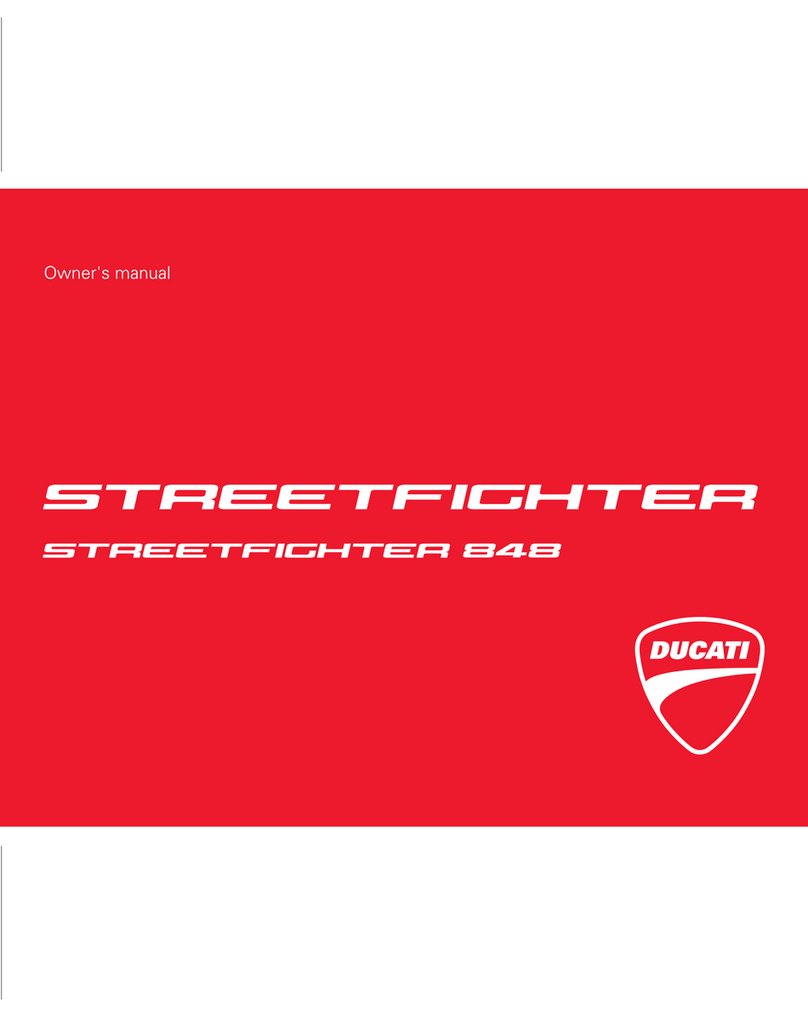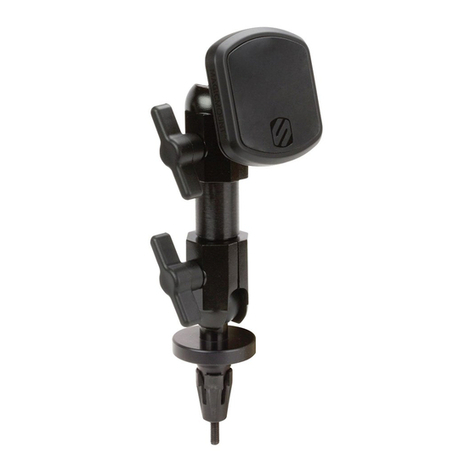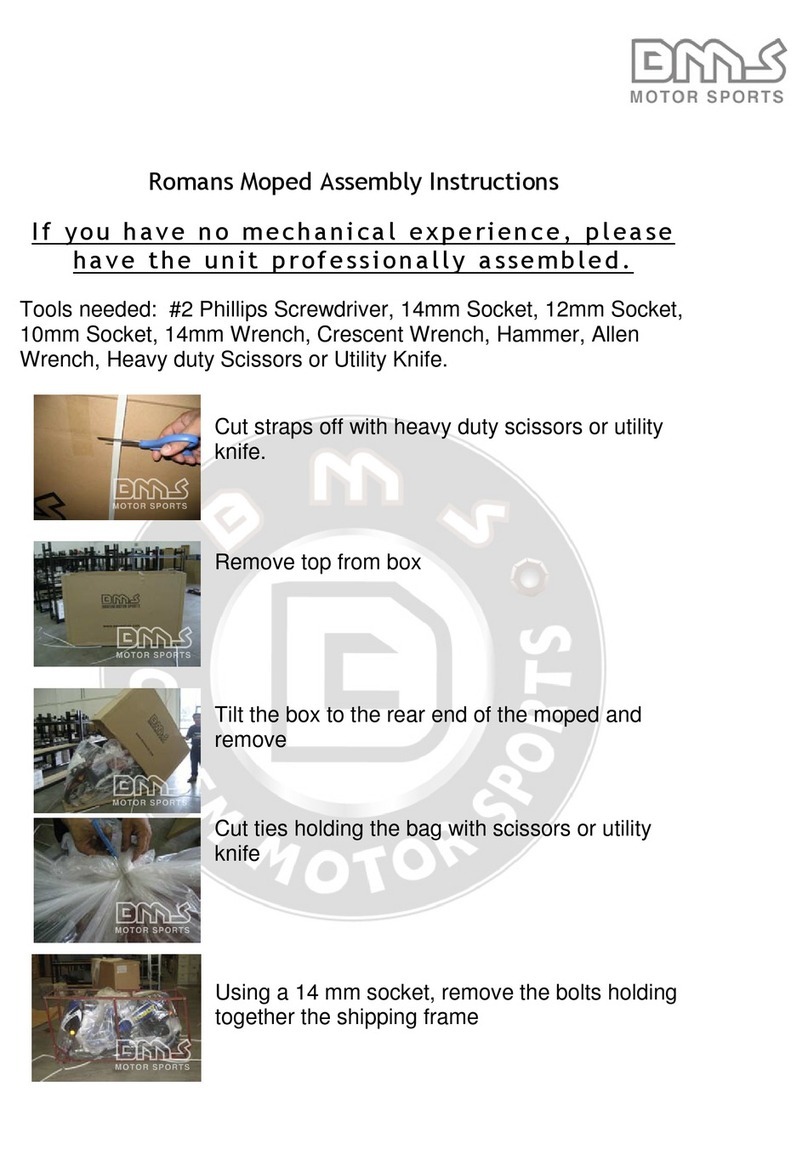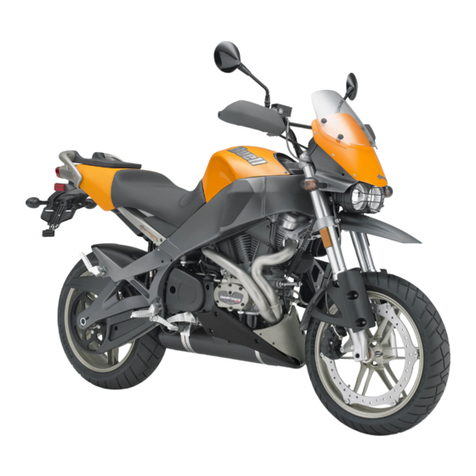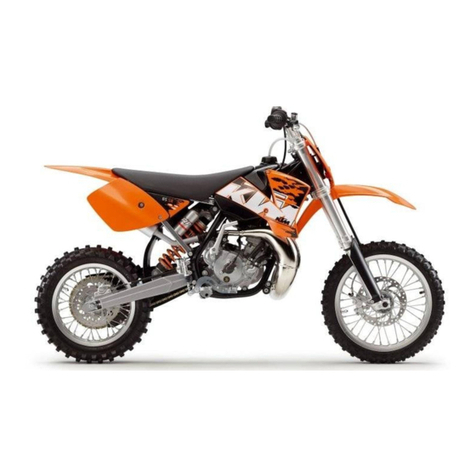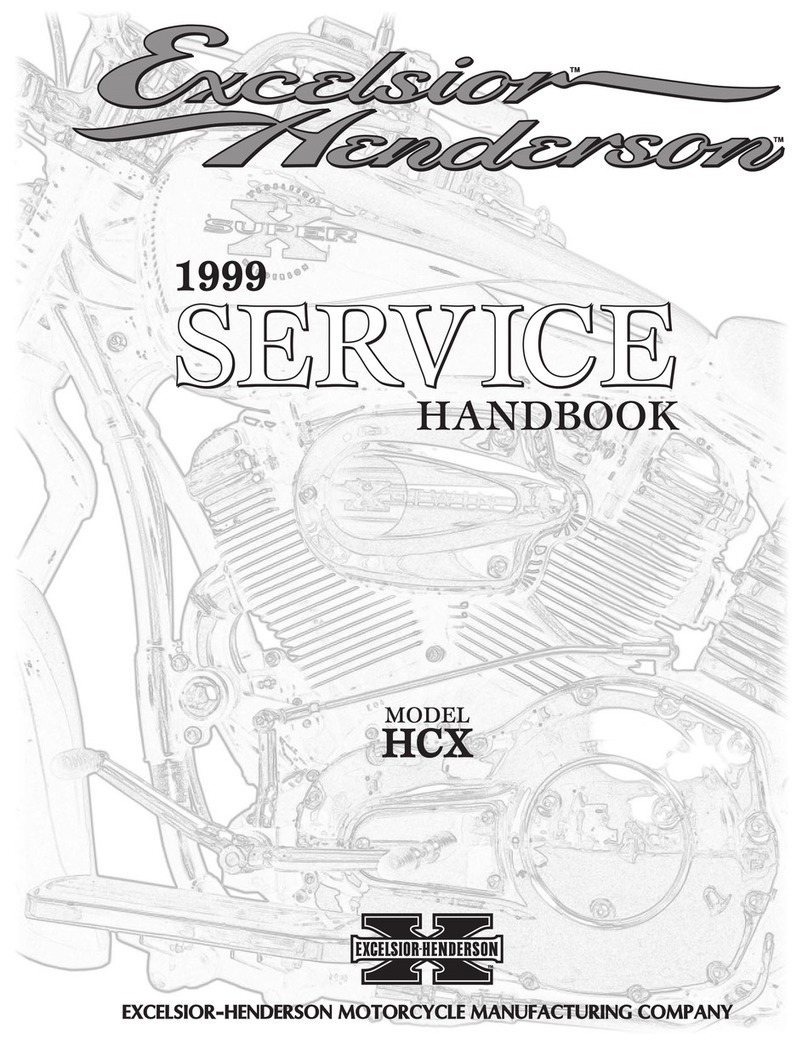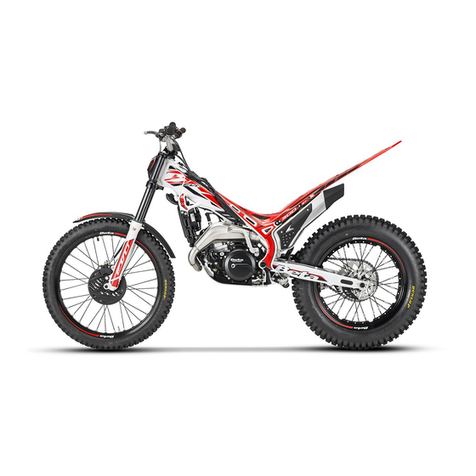MZ TS 125 Operating instructions

REPAIR MANUAL
for
the
MZ
MOTOR-CYCLES
TS 125
and
TS150
with
174
illustrations
and
23
drawings of special tools
4th
Edition
VEB
MOTORRADWERK ZSCHOPAU
Betrieb des IFA-Kornbinats Zweiradfahrzeuge

l
I
The motor-cycles of
types
TS
125,
TS
130,
ES
12511
and
ES
15011
are product8 from VEB Motorradwerk Zldropau
S
This Repair Manual was written by a team of engineers in the employ of VEB Motorradwerk Zschopau
VEB Motorradwerk Zsdropau reserve the right to modily or deviate from published specifications tor technical or
technological reasons at any time without notice.
All rights reserved
VEB
FACHBUCHVERLAG
LEIPZIG
Dead line: June
P,
1983
Photomeohanfcal print: Salzland-Druckeref StaOfurt
SG
157A30/84
RH
TS
1251150
und
ES
12511
U.
15011.
englisch.
g;.
Aufl.

Preface
111the high latitudes of Finland, in the parhing heat of Africa, under the mort
different operating conditions
MZ
motor-cycles run to the retidaction of their
owners.
To ensure that the vehicles, remain in perfect working order and reliable .in
service after a long period of operation, involving a certain amount of wear.
we issue this Repair Manual to give the necessary instructions to our
MZ
work-
shops
at
home and abroad.
Repair
WOI'~~
is a matter of confidence in several respects:
reliability and workmanship of the mechanic; the safety of the driver
depends on them.
finding the actual cause of the trouble; this ensures that no material
is wasted and labour costs are restricted to a minimum.
from this. three advantages result: no retouching work, short times of
inoperatiun and low repair costs.
A
good worksmanship in repairs largely depends on the use of the special tools
and means recom~~~endedby
MZ.
Authorised
MZ
Service-shops may obtain them
from the
R1Z
Spare Sales Department, whereas amateur constructors only have
the
possibil~tyof making them themselves. But to do it yourself you shbuld use
the sketches given in the Append~x.
U'e should like to underline that especially customers of "self-service work-
shops" and amateur constructors bear this in mind to avoid considerable addi-
tional expenditure of labour and material.
We hope this book of reference offers the required information to the staff of
the workshops conlracted for servicing our products at home and abroad and to
le friends of
MZ
motor-cycles throughout the world, and wewish good success.
VEB MOTORRADWERK ZSCHOPAU
~etrieb,des IFA-Kombinats Zweiradfahrzeuge
Service Dept.

Table
of
Contents
Tedmiecrl
Data
....................................
8
Engine
.........
Carburetter
.......
Electrical Equipment
...
Transmission
.......
Power Train
.......
Cycle Parti
.......
Dimensions and Masses
...
Capacities
.....
:
..
Characteristics and Diagrams
...............................
Fuel. Lubricmts and Fluids
12
........................................
Fuel 12
......................................
Engineoil
12
Gear011
......................................
12
...............................
Lubricants for Cycle Parts 13
Shock-absorber Fluid
.................................
13
...............................
Contact Breaker Lubrication
13
Dissossembly of the Engine
............................... 13
4
.
Assembling the Engine
..................................
16
.
S
..
Electrical E~ulpment
.................................
30
Dynamo
Checking
Checking
...............
the Armature for Accidental Earth
.
the Armature for Shorted Turns
.
.
Checking the Field Coil for Accidental Earth
.
Checking the Field Coil for Shorted Turns
.
.
Servicing the Carbon Brushes
.......
Servicing the Commutator
........
Fault Indication by the Charging Control Light
Adjustable Resistor
...........
Polarity Reversal in the Dynamo
......
Regulator Cut-out
............
..............
Adjustment
Mounting and Servicing
..........
Faults and Their Causes
.........
................
Battery
.....
Putting the Battery into Operation
Servicing the Battery
..........
Ignition System
............
..............
Ignition Coil
.............
Ignition Timing
Ignition Timing by Means of a Graduated Dial
.
Setting the Firing Point
.........
Sparking-plug
.............
Plug Cable Connector
..........
...............
Troubles
Electric Horn
.............
Ignition-light Switch
...........
Headlamp
...............

.................................
5.7.1.
Focusing the Headlamp
41
?
.............................
5.8.
Tail Lamp and Stop-light Swit&
42
v
5.9.
Flashing-light Direction Indicator System
...................
:
......
43
:
....................................
5.10.
Speedometer
44
v.
...................................
6
.
Induction System
44
l
l
..........................
8.1.
Carburetter BVF
22
N
1-3
and
24
N
1-1
45
.......................................
6.1.1.
General
45
6.1.2.
Description of the BVF Carburetters
22
N
1-3
and
24
N
1-1
...................
45
.
8.1.3.
Trouble Shooting and Tuning
..............................
47
7
.
Cycle Parts
.....................................
60
Exhaust System
...................................
50
Steering
......................................
51:
ES
12511
and
15011
...................................
51
................................
Removing the Handlebars 51
.............................
Front Fork and Steering Bearing 51
Replacement of the Swing-arm Bearing Pin
.........................
51:
TS
125
and TS
15C
...................................
52
Steering Bearing
...................................
52
Telescopic Fork (see Fig
.
136)
..............................
S!
FuelTank
......................................
571
l
Fuel Shut-off Cock
..................................
58
Brakes 58
1
.......................................
Replacement of the Foot-rest Tubes
............................
591
Checking and Changing the Secondary Chain
........................
59
Adjusting the Clutch
...................................
60
Removing and Dismantling the Rear Wheel Drive
......................
61
!
Speedometer Drive
..................................
62
.
1
Replacement of the Wheel Bearings
............................
62
Inspections Required in the Case of Poor Road-holding
....................
62
1
Repairing the Spring-loaded Suspension Units
........................
63
Shock-absorber Marking
................................
63
Removal of the Shock-absorbers
.............................
64
Common Faults in Shock-absorbers
............................
64
Filling the Shock-absorbers with Fluid
...........................
64
Mating Shock-absorbers
................................
64
I
Cable Controls
.....................................
64:
9
.
us(
of special Tools
...................................
65
8.1.
Engine
.......................................
65
9.2.
Cycle Parts
.....................................
65
9.3.
Electrical Equipment
.................................
85
10
.
Sketches for
Making
Special Tools
............................
66
Supplement: Repair Instructions for the Engines
12513
.
15013
and the Telescopic Fork with Aluminium Slide
Tube

Fig.
1.
TS
125
and
150
Fig.
2.
ES
12511
and
150/1

Fig.
3.
Sectional view of engine

1.
Technical
Data
1.1.
Engine
TS 125and ES 12511 TS 150and ES 15011
--
-
Type MM 12512 MM 15012
Strokelbore 58/52 mm 58/56 mm
Swept volume 123cm:' 143 cm'
Maximum output 7.35 kW (10hp) 8.45 kW (11.5 hp)
(at 6000 to 6300 rpm) (11 SAE hp) (12.5 SAE hp)
Maximum torque 12.3Nm (1.25 kp-m) 14.7 Nm (1.4 kpm)
(at 5000 to 5500 rpm)
,
Type of carburetter 22
N
1-3 24N1-1
Number of cylinders 1 1
Piston mass, complete with two rings, gudgeon pin and
locks 160
+
5 g 200
f
5g
Compression volume with the sparking-plug inserted
.
14.0 cm3 16.5cm"
Cycle two-stroke reverse scavenging
Cooling system air stream produced in driving
Connecting-rod bearing bottom, cage-type needle bearing
K
25
X
31
X
17
L
top, bronze bushing
Crankshaft main bearing 3 ball bearings 6303 c 3 f (silent, 17
X
47
X
14 mm)
lubrication by gear lubricant
Cylinder light-alloy, liner of special grey cast-iron onto which
the light metal is cast
Timing in crank degrees
inlet 150"
transfer 115"
outlet 165"
1.2.
Carburetter
Transfer
port
Main jet
Needle jet
Partial-load needle No.
Needle position, from top
Starter jet
Slow-running jet
Slow-running air screw
Throttle opening
Air filter
Float valve seat
1.3.
Electrical
Equipment
Ignition
Ignition timing
Contact breaker points gap
Sparking-plug
Electrode gap
Dynamo
Charging control light (red)
Regulator
Battery
Ignition coil
Headlamp (asymmetrical)
Tail lamp
combined with stop light
(3rd for running-in) (4th forrunning-in)
70 75
35 40
opened by
2
to 3 turns opened by 2 to 3 turns
3 mm 3 mm
dry air filter (paper cartridge)
15(1.5mm)
.
15(1.5 mm)
battery ignition
3.0-0.5
mm
before T.D.C., fixed setting
0.3 to 0.4 mm
M 141260
0.6 mm
direct current 6
V,
60
W,
short-time operation
90
W
in speedometer
RSC 6016, under left-hand panelling
6
V,
12
Ah
(flat lead storage battery)
6
V,
under left-hand panelling
ESTypes fixed
-
lamp opening 136 mm
TSTypes movable
-
lamp opening 170mm
ESTypes lamp opening 95 mm
TS
Types
lamp opening 100 mm
contact in rear brake
i

Flashing-light direction indicators ES
TSTypes
Flasher unit
Horn
By-pass light signal
Bulbs (data in parantheses apply to TSSpes)
bilux (twin-filament)
parking light
stop light
tail light
flashing-light indicator
charging control light
idling indication
speedometer illumination
1.4. Transmission
Clutch
Gear-shift system
Number of speeds
Gear ratios
1st speed
2nd speed
3rd speed
4th speed
Bearing on clutch shaft
Bearing on layshaft
Rearing on shaft gear
Idling indicating light
1.5.
Power Train
Transnlission
enginelgearbox
by sleeve-type chain
or double sleeve-type chain
(from 4th quarter of 1973)
Transmission
gearboxhear wheel
by roller chain
1.6.
Cycle
Parts
Frame
Steeringangle
Caster
Suspension system
front
TS 125and ES 12511 TS 150 and ES 15011
I
2-light system
at
the handle bar ends
4-light system
in headlamp shell
under fuel tank
actuated by push-button
arranged below dimmer switch
6 V, 45/40 W
passing beam asymmetric
6 V, 4 W, BA 9 s cap
6V, l8W, S 8.5 cap
(6 V, 21 W,
BA
15s cap)
6 V, 5 W, S 8 cap (BA 15S)
6V, 18W, S8.5cap
(6 V, 21 W, BA 15s cap)
6 V, 1.2 W
6V, 1.2 W
6V,1.2 W
multiple disk clutch in oil bath
foot-operated, left-hand side
4
3.05
:
1
1.805
:
1
1.285
:
1
1 :l
6202 (15
X
35
X
11mm)
6201 (12
X
32
X
10mm)
6004 (20
X
42
X
12 mm)
electric control bulb (green) in speedometer
2.31
:
1 37;16 teeth
A
9.5
X
9.5 ('18"
X
3/e") 48 links
2
X
9.525
X
4.77 (3/8"
X
3/16")48 links
3.2
:
1 3.0
:
1
f
48: 15teeth
C
48: 16 teeth
12.7
X
6.4
X
8.51
('l2"
X
l/,") 120rollers
continuous pressed-steel, seamed
TS 60"
ES 61"
TS 90 mm
ES
95 mm
C
TS telesco~icfork with hydraulic damping, total travel
of
spring
185
mm

rear
Wheels
Rims, frontlrear
Tyres, frontlrear
Tyre inflation pressure when loaded with:.
75 kg front
rear
150 kg front
rear
Permissible total mass
front
rear
Drake actuation
Brake diameterlwidth of lining
front
rear'
1.7.
Dimensions and Masses
Wheel base
Length
Height withlwithout mirror
(flat handlebars)
Height withlwithout mirror
(elevated handlebars)
Height with mirror
Width withlwithout mirror
(flat handlebars)
Width withlwithout mirror
(elevated handlebars)
Width with flashing-light indicators
Ground clearance, loaded, at prop stand
Weight unladen,ready for operation
with
fuel andtools
TS
ES
Permissible total mass
1.8.
Capacities
Gearbox
Fuel tank
including reserve
Telescopic fork
Suspensions units, rear
1.9.
Characteristicsand Diagrams
The maximum speed,'depending on sitting position,
is
about
100 kmlh for
the
TS
125and ES 12511
105kmlh for the TS
150
and
ES
1M/1
The maximum speed will only
be
reached
if the
re-
TS 125 and ES 12511
TS
150 and ES 15011
longitudinal swing
spring-loaded suspension
units
with hydraulic damp
ing, total travel of spring 150mm
spring-loaded suspension units with hydraulic damp
ing total travel of spring 105 mm, spring pre-load ad-
justable
wire spokes
1.60
X
18
1
1.85
B
X
18
2.75-18
1
3.00-18
150kPa (1.5 kp/cm2)
270 kPa (2.7 kp/cm2)
mechanically, by means of cable controls for both
brakes
about 1150
mm
7301620
mm
about 750 mm
140mm
0.45 1of GL
60
gear oil for summer and winter
12.5 1of petrol41mixture
about 1.5
1
220
cm3
of shock-absorber oil for each unit
70
a3
of shodr-absorber oil for each unit
quired favourable conditions are given (rider stooping
so
as
to
be
almost "lying", tightly fltting motoring suit,
plane road, no headwind).
The engine charaderi$tics, traffic fuel consumption,
and acceleration are shown
in
the following diagrams
(Fig.
4 to
9).

L...
..
..
.
---
.:o,V
4
000
5000
bow
n
in
mm-'
Fig.
4.
Full-load characteristics of the engine
MM
125!3: Fig. 5. Full-load characteristics of the engine
MM
150,/3:
rnas. output, mas. torque and specific fuel consumption max. output, max. torque and specific fuel consumption
Neo
[PS]
-
Neo
[hp]
Mdo
[kpm]
-
Mdo
[kp-m]
beo
[g,WSh]
-
beo
[glhp-h]
11
[Ulminl
-
n
[rpm]
Fig.
6.
Basic
fuel
consumption of
the
TS
125
and
ES
12511
Fig.
V.
Basic
fuel
consumption of
the
TS
150
and
ES
150/1
in top gear
(4th)
In top gear
(4th)

Fig.
I,
Maximum acceleration when starting from sta-
Fig.
9.
Maximum acceleration when starting from sta-
tionary state
(TS
125
and
ES
12511)
tionary state
(TS
150
and
ES
15011)
2.
Fuel, Lubricants and Fluids
2.1.
Fuel
According to the design of the engine, a petrol of an
octane rating of at least
88
(in the GDR abbreviated
as
"VK
88")
should be used.
In countries other than the GDR, the use of a fuelwith
a
similar rating is recommended.
If fuels of a higher octane number are used, readjust-
ment of the carburetter by resetting the partial-load
needle may be necessary.
2.2.
Engine
Oil
Engine oil is added to petrol in the
ratio of
1 :33
(e.g.
0.3
1of engine oil are added to
10
litres of fuel).
For other units of measurement we refer to the con-
version table
(see
Section
11.).
This mixing ratio also
applies to therunning-in period.
This simple and reliable system of petroil lubrication
supplies oil to the ?WOconnecting-rod bearings, cy-
linder liner, and piston.
Experiences gathered by us in the course of many
years have shown that it is advisable to use exclusi-
vely
MZ22
two-stroke engine oil.
This additive-type oil meets the following technical
re-
quirements
:
viscosity at
50
"C
20
to
25
cSt
pour point maximum
-30
"C
It contains additives which effect a high tem-
perature and pressure resistance. Limited
tendency to coking, prevention of carbona-
ceous oil deposits or loosening of them. Wear
reducing and corrosion preventing properties.
Contains lead separating agents preventing
whisker formation in sparking-plugs.
For
MZ
motor-cycles operated in countries other
than
the
GDR
we also recommend exclusive
use
of
two-
stroke engine oils which possess these properties (e.g.
Shell
2
T, Castrol
2
T, Arol
2
T, Mix01
'S",
LT-
2
T).
2.3.
Gear
Oil
For gearbox and primary drive, an amount of
450
an3
of
GL
60
gear oil is required.
This is an additive-type gear oil
which
is
particularly
suitable for the lubrication of
changespeed
gearboxes
and axle drives. It
is
an ageing-resbtant refined lubri-
cating oil with additives for an increase
of
load-bear-
ing capacity and a reduction of
wear.

It
.
as favourablelow-temperature properties and meets
the following technical requirements:
viscosity at 50 'C
(corresponds to about 8
'E)
53to 68 cSt
pour point maximum -25 'C
flashpoint 180 'C
water content 0.1
O/O
In countries other than the GDR, a gear oil with sinii-
lar viscosity values and properties should be used.
2.4.
Lubricants forCycle
Parts
The swing arm bearing and the worm for clutch oper-
ation must also be lubricated with GL 60 g e a r o i l.
(Oil-filled greasc gun: swing arm bearing to be lubri-
cated thoroughly until oil emerges from the lubrication
points:
WOITII
for clutch actuation to bc lubricated by
2 to
3
strokes.)
The following lubricating points of the cycle parts must
bclubricated \vith"Ceritol
+
k2"or"Ceritol
+
k
3
"
antifriction bearing grease:
steering bearing. wheel bearings, bearing for
~.car-\vheeldrive, secondary chain, brake cam.
brake shoe bearings, and speedometer drive (the
latter only \\.hen being n~ountedor repaired).
This antifriction bearing grecse has a pour point of
about
130
to
150
"C,
can be used for a temperature
range f~wn
-30
to
+lOOaC,
and is water-resistant ct
-+50
'C.
in countries other than the GDR, an antifriction bear-
ing grease of similar characteristics should be used.
2.5.
Shock-absorber Fluid
For the telescopic fork and the spring-loaded suspen-
sion units, a shock-absorber fluid of a viscosity of 8 to
11 cSt (corresponds to 1.65 to 1.9?
"E)
at 50 "C should
be used.
The damping characteristics of the telescopic fork and
the spring-loaded suspension units are based on this
viscosity. Springing and roadability will be impaired
if
shock-absorber fluids of a different viscosity will be
used.
2.6.
Contact Breaker Lubrication
For contact breaker lubrication, the special oil for igni-
tion circuit breakers, in the GDR known as "Unter-
brijl", should be used; it possesses a viscosity of from
500 to 1,300 cSt at 50 OC.
If this special oil is not available, a high-viscosity gear
oil of similar viscosity properties can
be
used.
3.
Disassembly
of
the
Engine
Remove the closing plate and the dynamo cover,
dirc
connect the cables from the dynamo (disconnect the
plugged connections).
If the identacation colours of the various cables
are
not clearly discernible, it
is
advisable, especially for
amateur ccnstructors, to attach paper slips with mark-
ings
(D+,
DF
and frame) to
the
cables to save
the
work of measuring them for reassembling,
Loosen thc t\vo f;~b~csn~ng
sc;.\\h
(SCY,
;II.I.#)\~S)of the
tc~.n-iin;ll
casing
;ind
rc~nio\.c~1hc7
I,III~~I.
(it
is
mounted
on
a
centring
dcvice
and
locating pln).
Unscl-c-\\.thc al,mntul.c f;~slcnlnl:.;cl.i5\\.
(1)
and
rcmove
the Inlcl.1.uptci.
tarn
T;akc>
c.;II.~~
nalr 10
d;lm,rgc~the face
of
the
con-rmutato~~
to
insul.c,
I~;II
the'
cam \\.ill continue
to run properly.
FIG
11
Ren~o\lngthe pole
casing
Use puller 02-MW 39-4 or a screw M 10x100 for re-
moving the armature. By means of other tools,
eg.
a
claw-type'puller, either the winding will be damaged
or the segments will be deformed.
Keep the plate disk ("key") in a safe place!
\1
fig.
12.
Pulling
off the armature

For loosening the nut of the gearbox sprocket, bend
up the lock plate, using the sprocket-holder 05-MW
45-3
to retain the sprocket.
(
L
e
f
t
-ha
n
d
t
h
r
e a d
!
)
Remove cover plate (1) and sealing cap (2).
1.'~;
1.5.
D~smnntlin::the clutch drivel
Fi;
1'3
Removing the gearbox sprocket
Lf,(wn
the clamping scre\v of the kick-starter and that
trl
~lic
gear-shift pedal and remove the two controls.
Looaen the clutch cover by tapping against it close by
tlie fitting pins (A),using
a
rawhide malle., and remove
the cover. Do not use
a
screw-driver to
f
n
r
c e o
f
f
t h e c o v e
r
because time-consuming
wfinishing operations will be necessary to restore the
cover to a proper leakproof condition! Press down the
spring plates by means of tool 11-MW 15-4 and pu~h
nut the pins.
Fig.
14.
Dismounting
the
clutch
Loosen the nut on the clutch shaft (use a spanner with
awidthoverflats19).(Left-handthread!).For
this purpose use the holders 01-MW224 (1)and 12-MW
5-3 (2). Unscrew the nut (width over flats 19) from the
drive pinion (right-hand thread).
An amateur constructor may rivet or weld a round
iron bar having
a
diameter of 10mm and a length of
about 200 mm to an old clutch disk of steel. The tool
produced in this way (similar to a signal disk) can be
used in the place of the two holders. The internal teeth
will retain the
clutch
driver, the round bar the clutch
drum.
Remove the dri\.ing :'p~.ockc%lby mt3;in.;
t11
p~~ller
12-MW
23-4
(A).
The vent bores
at
the pinion for the dupltss
ch;tin
are
arranged closer together!
Remove pinion uith chain and clutch basket.
Keep the plate disk ("key")from the
end
of
~ht,
cmnk-
shaft carefully so that
it
cannot be lost!
Dismount cylinder with head (gradually loosen the
hexagon nut crosswise) and the piston. Remove the
,gudgeon pin lock ring by means of a pair of taper-nose
pliers and press out the gudgeon pin by means of the
Grift 22-50.010.
Fig.
17.
Dvivinr:
out
thc.
:udcer,n
pin

Remove all of the
14
casing screws from the right-
hand side of the casing.
For.= out the fitting sleeves at the front and rear en-
gine mounting by means of the offset drift 11-MW
3-4.
Fig.
18.
Driving
through the
fitting
sleeves
Engage the fourth speed of the
gearbox.
Lift off thc
right-hand casing half by means of the separating
screw 22-50.012.
Facilitate this operating by slightly tapping uVith
a
rawhide mallet (see arrows).
Then, proceeding from the bottom, beat out upwards
both clutch shaft and layshaft by means of a copper
mandrel (screw thread!).
For this purpose. move the gear-shift wheels so that
the slotted section easily slides through the gear-shift
wheels, otherwise the gear-shift dog will be deformed.
Fig.
19.
Pulling
off
the
right-hand casing half
F
Gear-shift detent shaft (1) must then
be
screwed out
after bending up the lock plate and unscrewing the
t
r.ut
at the clutch side.
Bend up the lock plates for the fastening screws
(2).
and
(3)
of the retaining plate with gear-shift segment
and loosen the screws.
Now, the complete gear-shift mechanism can be re-
moved.
Fig.
10
U~srnnntl~ngthe geill -.4~1l
I
~nechan~bm
Do
n
o
t
b e
a
t
o
U
t
-
c~,;~nkshafts\vhohc cwds arc
heavily damaged will not
bc
accepted by iqxrir-shops.
If the gearbox bearings hnvc to be replaced
by
new
ones, remove thc lock rings
(sec
arrows)
by
means of
a
pair of taper-nose pliers.
Fig.
21.
Pushing
out
the crankshaft by means of the
22-50.013
pusher
For the removal of the ball bearings. h e a t the cas-
ing halves to a temperature of about 100
"C.
This will
facilitate dismounting without damaging the bearing
seat.
Beat out the bearings for clutch shaft and layshnft
from the interior to the outside.
As to the 6303 crankshaft main bearings take into con-
sideration that a lock ring (l)
is
arranged between these
two bearings (see Fig.
3).
First beat out the outer bearing, from the inside of
the casing, using
a
mandrel. Then remove the circlip
by means of a pair of taper-nose pliers and push out
the inner bearing
-
together with the packing ring
-
using drift 11-MW
7-4
and proceeding towards the
inside.

Fig.
25.
Dismantling the ball bearing
Push the crankshaft main bearing
6303
with packing
ring out of its seat in the heated right-hand casing
half, using a suitable drift and proceeding from out-
side to the inside.
The delivery and return pipes for lubricating the
crankshaft bearing
a1
the dynamo side and the lay-
shaft bushing must be cleaned to remove lubricant
remains, and then blow compressed air through them
(see arrows).
A
careful cleaning of all engine parts is indispensable
for reliable trouble-shooting. Do not only check and re-
place those parts which cause functional troubles hut
check and measure all parts and points subject to wear.
This is the only way to avoid another repair after a
short time of operation.
Fig.
23.
Oil bore-holes of the right-hand casing half
4.
Assembling the Engine
.After having cleaned the engine parts carefully, the
first thing to do is to treat the two halves of the cas-
ing, the clutch cover and the cylinder head.
The joint faces are checked on a surface plate and
touched
up,
if
required (using emery cloth), until all
scratches or sealing compound are removed. Then and
only then, the engine will become perfectly gastight.
If
a
surface plate is not available, the table of a ma-
chine tool, e. g. a column-type drilling machine, will
do good service.
Fig.
24.
Re-finishing the sealing surfaces
The next thing to do is to insert the circlips (locking
ring) for the crankshaft main bearing and the clutch
shaft and layshaft bearings into the left-hand half of
the casing, using a pair of taper-nose pliers; the half
of the casing must be heated to a temperature of
a b o
U
t
100
"C
on an electric cooker.
This is necessary to facilitate the insertion of all bear-
ings, especially,
to
prevent them from being tilted and
the casing bore-holes from being damaged (bearing
location). On no account use a welding torch for heat-
ing
-
due to local overheating the casing may get
distorted.
Fig.
25.
Heating the casing
Please notice:
Bearingfor clutch shaft
=
closed end of the cage point-
ing to thegearbox.
Bearing of layshaft
=
open end of the cage pointing
to the gearbox.
For fitting use a bolt or
a
piece of a tube (must be clean
inside!) having a diameter from 35 to
32
mm.
C.!

Fig.
X.
Mounting the
genrbos bcnr.in;b
(A)
Vrnl
01
thr
gcnrbnx
cns~nl:
Pig.
27.
Inserting the cl-anl<.li:ifthenring
at
the left-hand
bide
Note that all operations regardmg the mounting of
the crankshaft and of the gear-shift mechanism must
be
finished before the temperature of the casing drops
below
70
"C.
Therefore. check all parts to be mounted before Etting
them or replace them by new ones, if required, and
place them on
a
clean surface. together \vith the neces-
sary tools, so that they
alc
ready at hand for mount-
ing.
Every crankshaft, xvheter it is a new one or a regen-
erated one, must be checked for true running before
mounting. It may have been distorted during trans-
port or when it was dropped inadvertently. When
mounted in this improper condition, premature wear
of the crankshaft bearings and poor engine output will
bethe result because the contact breaker cam fails
to
raise at the specified point or raises twice.
If there is no test stand for true running available,
the checking operations involved may also be per-
formed between the centres of the lathe.
The amount a crankshaft may be out
o
f
t r
U
e at all measuring points is 0.02 mm.
Fig.
28.
Checking the crankshaft for true running
.The r a d i a l
p
l a
y
of the connecting-rod .provided
with needle bearings in new condition must be
0.015 to 0.030 mm
Maximum amount of wear, limit
0.05 mm
The running clearance of the small-
end bush, new condition, is
0.020 to 0.030 mm
Amopnt of wear, limit
0.045 mm
It
should be noted that the small-end bushes normal-
ly
are worn out in such a way that they become oval.
Fig.
29.
Checking the connecting-rod bearing
Worn out small-end bushesare replaced
by means of.the 11-MV 60-3 fitting device. The new
small-end bush of f i n a l
s
i
z
e is put on the device
and,'when tighteningthe nut, presses theold bush out
of its seat.

Take care that the lubricating holes to
be
drilled end Do not force the crankshaft through a cold bearing
be
in the oil catch pockets. cause this will render it useless (out of true) before it
Remove
all
burr from the holes. has run. Then the contact-breaker cam lifts anywhere
See
to
it that the fit is not too narrow
-
the sliding but not on the cam lobe! Or the primary &in is
al-
bearing requires a continuous oil film. ternately slack and taut during one revolution.
Fig.
30.
Replacing the sn)all-end bush
The a
X
i a l c l e a r a n c e (see double arrow) of the
connecting-rod in the crankshaft, in new condition, is
0.25 to 0.40 mm
When the connecting-rod is copper-plated on all sides,
this clearance is reduced to
0.13 to 0.36 mm
With an axial clearance of 0.55 mm, the crankshaft is
worn out.
The crankshaft (Fig. 31) is used unchanged for the
engines of the ES 12511, TS 125, ES 15011 and TS 150.
It may happen that the connecting-rod of a new crank-
shaft was deformed by improper transport or storage.
As a distorted or oblique connecting-rod will wear
down the small-end bush before long, check the con-
necting-rod in any case.
Pig.
32.
Mounting the crankshaft
Wear limits at the gear-shift mech-
anism
-
cauSes of gear-shift faults:
(1) Bolt at the retaining plate has a clearance of mcjre
than 0.3 mm
(2) Cut-out in the retaining plate worn down more
than 0.4 mm (size in new state 20.6:., mm)
(3) Window in the segment lever and dogs of the
gear-shift member heavily worn (round)
(4) Return spring slack
(5) Gear-shift dog worn down more than 0.3 mm or
blue discoloration (size in new state5
~::~~~
mm)
(6) Spring or ball (6.35 mm) jams in the gear-shift
fork
Fig.
31.
Crankshaft
.
Fig.
33.
Gear-shift mechanism
'
Oil the crankshaft end.
At the re-heated casing half, h e a t the i n n e r Screw the retaining plate with gear-shift segment in
r a c e o f t h e c r
a
n k
S
h a f t b e a r i n g by place and fit the lock plates.
means of a heated mandrel.(l) in such a manner that Insert gear-shift shaft with gear-shift member; prior
the crankshaft slides to the shoulder due to its
own
to this operation slightly oil the bearing area of the
.
weight.
.
shaft.

Screw the gear-shift detent axle in place and adjust it
by means of the setting gauge 11-M1
8-4
(the arrow
indicates the references groove).
The check nut (place a lock plate under it) must be
tightened before taking measurements.
tightening the nut changes the setting.
If
the gauge is not available, adjust according to the
instructions given in Fig. 38, using a block gauge.
Fig.
34.
Setting the gear-shift detent axle
Gear-shift dog to be pushed on the gear-shifr detent
axle together with compression spring and ball. press-
ing the ball into the bore-hole by means of a screw-
driver.
I- ~t the gear-shift lever in place and shift the gears.
During this operation check that the dogs of the gear-
shift member properly engage
(
e n
g
a ge m en t
minimum 1 mm, maximum
3
mm) and that
the elastic segment lever does not jam when the gear-
11
the edges of the keywas in the clutch shaft
(1)
and
layshaft (2) and their gear-shift wheels [2nd and 4th
speeds
(3)]
have become severely rounded or are even
broken out, then they must be replaced by new ones.
Check the woi-king surfaces of the bearing collar at
the pair of gear-shift wheels for the 1st and 3rd
speeds (4) for wear marks. When using new parts take
care to see that these parts are properly matched
-
black colour dot to black and white to white!
Check the gear for the 1st speed
(5)
that the edges of
the window are in a proper state and that there are
no cracks.
Check the bush of the shaft wheel
(6)
for wear.
The amount the clutch shaft may be
out of true is
0.05 mm
Realignement should only be effected by pressing but
never by beating! It is advisable to check the shaft
between the centres of a lathe and then adjust it.
shift member returns. If necessary, restraighten the
retaining plate.
Fig.
35,
Inserting
he
gear-shift pawl
Check all dogs of the gear-shift wheels for wear. The
undercut of
5"
must bear for at least
'14,
otherwise this
part and the gear with which the worn dogs engage
must be replaced.
The gears under load are retained in mesh by the
un-
dercut but not by the gear-shift mechanism detent de-
vice on the axle.
Fig.
37.
Causes of faults in the gear-shift set
If the setting gauge shown in Fig. 34 is not available,
use a "block gauge" having a height of 13.0 mm; this
gauge should be specifically made for this purpose.
With the 3rd speed engaged it must be pos-
sible to insert this gauge while a slight resistance can
just be felt. If this is not the case, readjust with the
gear-shift detent axle until the distance is correct.
With the 4th speed engaged, a distance
of 0.1 to 0.2 mm is required between gear-shift
wheel

of the 4th speed'&d the shaft wheel
-
the 6004 shaft Apply a thin film of jointing compound
wheel bearing must not be exposed to axial pressure! t
o
t h e
s
e
a
l
i n g
s
U
r f
a
c e
s
(most of the joint-
(See Flg.
38,
page
21)
ing compounds can be diluted with nitro diluent). Do
not smear over the tapped holes or the gearbox vent
Oil all journals and shafts. Put the gear-shift wheels
for the 2nd to the 4th speeds on the clutch shaft and
push the latter into the ball bearing. At the same time
insert the finger of the gear-shift pawl into the guide
grooves of the gear-shift wheels. Use a rawhide ham-
mer to drive the shaft up.to the stop. During this
operation, the gear-shift pa-wl is in the 4th speedy
At the layshaft, first fit the gear (provided with a
window) for the 1st speed (smooth side pointing up-
wards), then insert the pair of gear-shift wheels for the
1st to 3rd speeds with the guide collar into the mating
wheel and put the layshaft through. At the same time
turn sideways until the keyway slides through the
gear-shift \\-hecls.
Usc
a
i.i\\vhid(,hammer to drive the layshaft up to the
stop.
(Fig.
26)
!
Put the casing half in place and properly
Bt
it by applying slight blows with a rawhide mallet.
Readjust the bearing 6004 at the shaft wheel by means
of the 11-MW
7-4
drift.
Drive the two fitting sleeves (see arrows) in place,
using the 11-MW
3-4
drift.
Fig.
41.
Mounting the right-hand casing half
Tighten all 14 cas i ng s c r e
W
s by means of a
properly fitting screw-driver (if possible use a breast
drill) [maximum torque 12.7 Nm (1.3 kp-m)).
Observe the correct succession, namely:
Starting in the centre of the casing, then tightening
alternately and crosswise right-hand and left-hand
Fig.
39.
Mounting the gear-shift set screws (order indicated by numbers in the illustration).
Put the shaft wheel (1) in place and check the contact
plate for the neutral indicator
(2)
-
if necessary,
straighten the plate (dimension "A" 10 to 11 mm
-
while the gear-shift shaft is pressed down).
Meanwhile, the right-hand half of the cas-
i n
g
has been heated to a temperature of about 100 "C
and the crankshaft sealing ring (from the inside) driv-
en in (press in rings without steel coat) so that it is
flush with the inner edge of the casing
-
sealing lip
pointing outwards (see Fig.
3).
The inner race of the 6004 bearing must be heated by
means of a mandrel and then fitted into the casing by
means of the 11-MW 7-4 drift.
Fig.
40.
Left-hand casing half readily mounted
Make haste to ensure that the casing is still warm
enough for the next operations.
P.
Fig.
42.
Tighteningthe casing screws
Use a heated mandrel to bring the inner race of the
6303 bearing to a temperature of about 80 "C and,
using the 11-MW
7-4
drift, apply
s
l
i
g
h
t
t
a p
s
to
insert it until it contacts the collar of the crankshaft
tail end.
Especially
in
the right-hand crankshaft bearing ev-
erything depends on the fact that the cold outer race
slides in
the
hot casing
-
and the hot inner
race
of
the bearing on the cold end of the crankshaft
-
when
This manual suits for next models
1
Table of contents
Other MZ Motorcycle manuals

